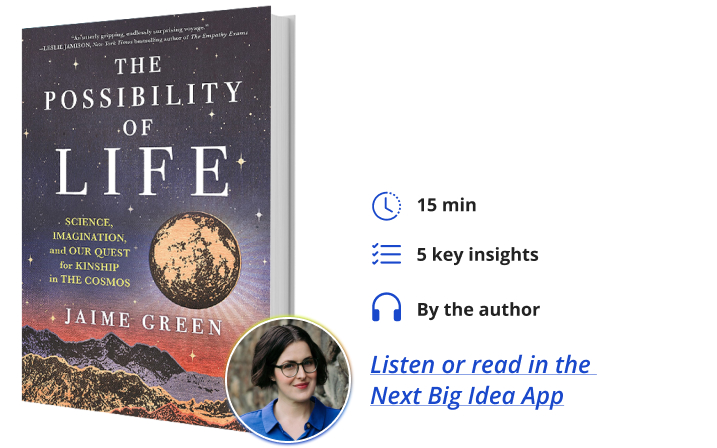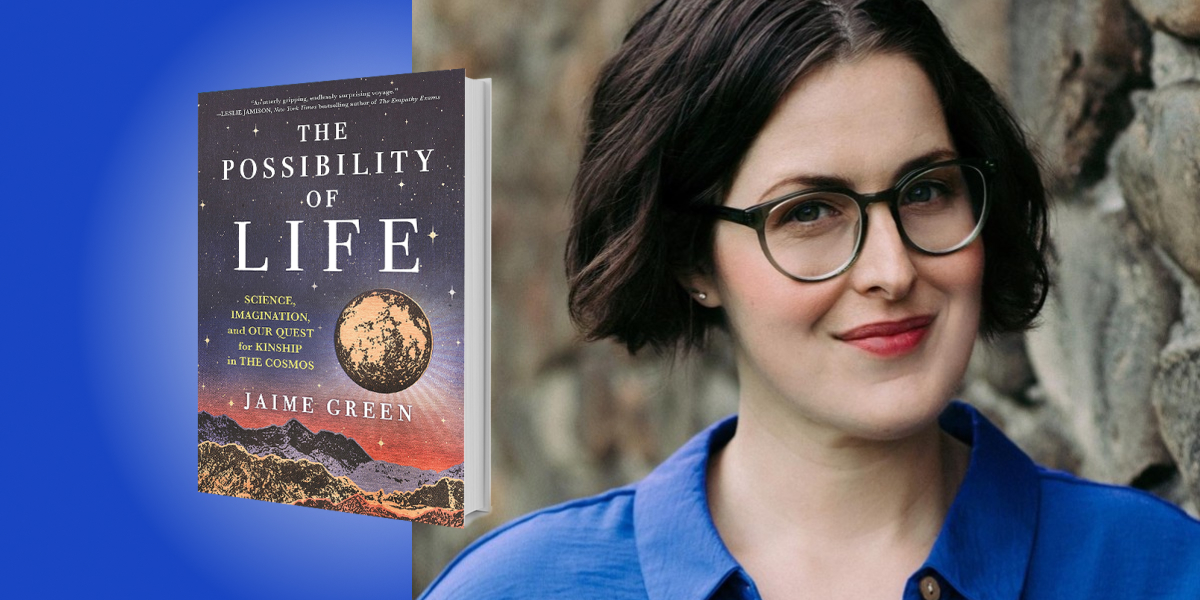Jaime Green is a science writer, essayist, editor, and teacher. She received her MFA in Creative Nonfiction from Columbia and her writing has appeared in Slate, Popular Science, The New York Times Book Review, American Theatre, Catapult, and Astrobites. She is series editor of The Best American Science and Nature Writing and a lecturer in English Language and Literature at Smith College.
Below, Jaime shares 5 key insights from her new book, The Possibility of Life: Science, Imagination, and Our Quest for Kinship in the Cosmos. Listen to the audio version—read by Jaime herself—in the Next Big Idea App.

1. Scientific knowledge puts limits on our imagination.
During the European Renaissance, new discoveries filled the cosmos with possibility. When Copernicus realized the Earth wasn’t the center of the universe, when Galileo discovered that the “wandering stars” were planets or that the Milky Way was actually full of stars, the universe seemed full of potential. The storytelling about life on other worlds exploded.
It was only thanks to these types of scientific discoveries that other worlds could be imagined. Before Copernicus and Galileo, as anthropologist John Traphagan wrote, Europeans couldn’t really imagine worlds beyond the solar system, let alone worlds other than Earth, inhabited by other intelligent creatures. It wasn’t just that they didn’t have the necessary facts, Traphagan argues, they were simply limited by the boundaries a culture places on what is imaginable: our inventive abilities can really only extend so far. Before Copernicus and Galileo, people weren’t imagining aliens on other planets because other planets weren’t understood as places where a person—alien or human—could be. Once other worlds were made available to imagination, those stories came in like a flood.
2. Imagination can stretch.
When we imagine extraterrestrial life, we push past the limits of scientific knowledge. It’s like going out on a limb, testing its strength, and then looking back at ourselves from a new distance. Imagining alien life requires asking questions about life on Earth. How did it arise? Why is it the way it is? Are we special, and what would that mean? What is our responsibility with the intelligence and technology that we have?
Imagination isn’t unscientific, it drives every hypothesis and prediction, every leap and act of synthesis that moves us from the unknown toward knowing. Scientists imagine things every day. They imagine a possible chemical pathway and test it. They imagine the surface of a distant planet, about which hardly anything is known, and render it as artwork. They imagine the evolutionary lineage of a parallel Earth, the near future, and the outcome of unprecedented events.
“Imagination isn’t unscientific, it drives every hypothesis and prediction, every leap and act of synthesis that moves us from the unknown toward knowing.”
So fiction is like a big stretch for that skill, to give our scientific imaginings a better range of motion. All alien stories are in some way about the tension between looking for kinship and seeking strangeness—anthropocentrism versus the desire to be able to imagine something else. Imagining aliens means imagining not just physiology but impulses and desires too, maybe even inner life. So the leap of faith isn’t just cognitive, but also empathetic. There’s a cosmic humility to be found in understanding that we’re just one of life’s infinitely diverse potential expressions. Even if we can’t imagine truly strange, truly different lives, we push against the limits of our imaginations when we try, and in doing so, we stretch them a little farther.
3. The cosmos is way weirder than we expect it to be.
An important idea guiding our exploration of the universe is the Copernican principle. Copernicus showed that the Earth isn’t the center of the Solar System. In the centuries since, we’ve learned that not only is the solar system not the center of the galaxy, but our galaxy isn’t the center of the universe, and our universe may not even be all there is. The Copernican principle reminds us to never assume humanity is special. However, that doesn’t mean we, or Earth, or the Solar System, are average.
In line with the Copernican principle, the assumption before we’d found planets around other stars was that our solar system would turn out to be average. However, when scientists started finding Exoplanets, that model had to be abandoned. The first planet found around a sunlike star, 51 Pegasi b, is 150 times bigger than the Earth, or about half the mass of Jupiter. However, it orbits closer to its star than Mercury orbits the sun. Exoplanets aren’t particularly common, they maybe represent one percent of planets, but being huge and having very short orbits, they were the easiest and fastest to find. They taught us that our models of planet formation couldn’t just be based on what we knew around the sun.
We need to remember that as rigorous as we may be, our imaginations are shaped by what’s familiar. When we think of life on Earth, we think first of the life we see: animals and plants, maybe fungi if we’re feeling expansive, but most of life on Earth is nothing like that. Most of life on Earth is actually simple single-celled organisms, bacteria, and archaea. They break so many of our assumptions about life, living in environments we’d assume aren’t habitable. Inside rocks or toxic sludge, for example, subsisting on energy from impossible sources like inorganic minerals or radiation. The cosmos is similarly full of surprises.
4. We may never know when it’s aliens.
In the fall of 2020, word came that a sign of life had been discovered in the clouds of Venus. Researchers reported the detection of phosphine, a simple molecule consisting of a phosphorus atom and three hydrogen atoms in Venus’ clouds. They had ruled out all non-biological mechanisms that could account for its presence. The mood among the scientific community was a mix of excitement and skepticism, and skepticism eventually won out. As the story faded from public awareness, further research, in parallel to the original study and in reanalysis of its data, showed that not only was this not a sign of life, but the phosphine detection may have been a false alarm entirely.
“We get closer and closer to an answer, but especially in terms of the search for alien life, a decisive ‘a-ha’ may never come.”
Yet, aside from some overzealous news headlines, this is exactly how science is supposed to happen: tentative claim, rigorous investigation, copious caveats and qualifications. We get closer and closer to an answer, but especially in terms of the search for alien life, a decisive “a-ha” may never come.
Historian of science Steven J. Dick warns against expecting an immediate discovery. He says that’s not really how science works. What in retrospect may look like a eureka finding actually always involves at least three distinct stages. Dick labels those stages as “detection, interpretation, and understanding.” When it comes to the search for life elsewhere, at least with our current technology and what’s coming in the next few decades, the possibility of decisive understanding is thin. The James Webb Space Telescope may be able to detect bio-signatures in exoplanet atmospheres, but that just means molecules that, on Earth, with geochemistry and biology that we know, tend to go along with life. Even a radio signal may not be decisive. The 1977 “Wow! signal,” detected by the Big Ear radio telescope in Ohio, was never explained, nor explained away.
We hope for a decisive discovery, and that’s what we see in movies and books, but this is where the scientific likelihoods and fictional imaginings diverge. Barring the kind of “Hello, Earth, this message is for you” transmission Carl Sagan imagined in Cosmos (or the dramatic landing of the Vulcans in Star Trek: First Contact), we may be forever left with “maybe” and “what if.”
5. Our search for aliens is really about humanity.
One of my favorite tropes in alien stories is the alien telling humanity what they think of us. In Contact, the alien tells Ellie that “love is very important” to humans, and “You humans have a certain talent for adaptability.” In Octavia Butler’s novel, Dawn, an alien tells a human that her species is “intelligent [and] hierarchical … It’s a terrestrial characteristic.” In the context of other species, Star Trek’s humans understand themselves by contrast: Vulcans are logical, Ferengi are avaricious, Klingons are warlike. Aliens give us a new context within which we can understand ourselves.
It’s not only those explicit comparisons that let us learn about humanity. In trying to understand ourselves, we’re stymied by the fact that this is the only planet with life that we know. With nothing to compare ourselves to, and no real context within which to situate our knowledge, we’re left to imagine other possibilities. Every alien story is, in its way, a story about humans and life on Earth. Alien ecologies are a way of imagining other paths evolution could’ve taken; alien intelligences are ways of imagining how else a “person” could be.
“Aliens give us a new context within which we can understand ourselves.”
When it comes to stories about super-advanced aliens especially, we’re trying on possible futures for ourselves. Sometimes it’s aspirational, like the utopia of Star Trek, and sometimes it’s a cautionary tale. Often it’s a way of testing out the implications: what happens if this is where we’re heading? What are the ethics of such a future? We look to the stars, to the future, and hope or wonder: that could be us, too.
The real-life search for aliens is the search for this sort of understanding. The anthropologist and nature writer Loren Eiseley writes, “There is nothing more alone in the universe than man.” The fact that we are the only ones on Earth who seem to long for this kinship makes its absence even more painful.
Finding alien microbes would help us understand why Earth’s biology is the way it is. Extraterrestrial evolution would help us find the limits of Darwin’s vision. Encountering alien intelligence, whether through a signal, artifacts, or a message for us, would finally give us someone to ask, what’s it like to be you? Which is our way of asking what it’s like to be ourselves.
To listen to the audio version read by author Jaime Green, download the Next Big Idea App today:































